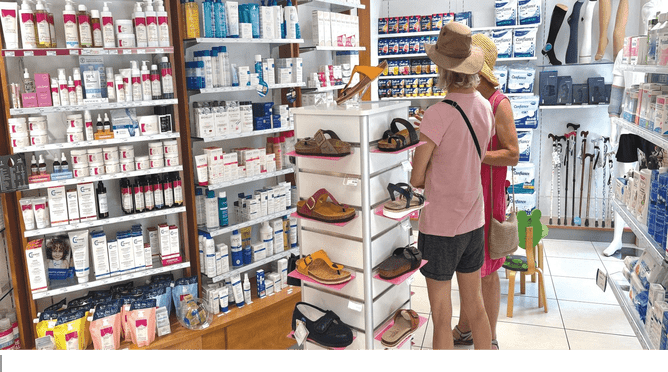Article featuring insights from John, written by Paulette Crowley for Pharmacy Today - September 2025.
Reimagining retail’s function within independent pharmacies
Paulette Crowley - Pharmacy Today magazine:
Is there a future for retail in independent pharmacies, or has that been totally eclipsed by discounters? Paulette Crowley looks at where retail sits and if there is still a way for independent pharmacies to compete.
“Retail is the last thing on my mind, to be honest. We’re far from thriving – we’re just trying to survive,” one pharmacist I rang for this article told me.
That pharmacist, who asked not to be named, was the fourth I’d spoken to. All were approached because their retail offering was considered top-rate by a colleague.
However, all four pharmacists insisted the retail side of their business was at best limping along as they focused on developing clinical services to remain sustainable. The “scourge” of discounters had well and truly buried their retail lines, one said.
So, was this just another pharmacy funeral? Not necessarily, says John Saywell, CEO of RPM Retail. He sees a bright future for retail in independent pharmacies, albeit as part of a business strategy that focuses on dispensary and clinical services first.
The former pharmacist and co-founder of the Independent Pharmacy Group (IPG) says the sector is still riding the huge wave of post-COVID- 19 pandemic change. He says pharmacy’s shape is on the move – “it always has been” – but it’s now time for people to get a solid business strategy, which should definitely include retail.
Sort out ‘engine room’
“Fixing” retail is the least important thing on the to-do list if the rest of your business hasn’t been adapted and developed for the current climate. Dispensaries need to get bigger and better organised because they are the “engine rooms” that drive customer flow, Mr Saywell says.
He believes many dispensaries are not fit for the requirements of the modern workplace. And in many cases, dispensaries are wildly out of shape for the volume and complexity of dispensing. Working in cramped areas that were designed for workflows from decades past is not sustainable.
“I can think of dozens of pharmacies that I walk into and see four, five, six or seven or more people in a space that is not set up for the current workload. Without doubt, all of the pharmacies in New Zealand have underinvested in their premises over the last 10 years.”
A re-engineering of the dispensary “engine” should be prioritised to catch up with modern requirements but also position them for the future, which will include more robotics, he says.
Once that engine room is optimised and efficient, developing clinical services can take place, which requires room for consulting spaces.
That often comes at the expense of retail, which has traditionally taken up prime real estate in pharmacy.
Pivot to Premium
This is the perfect opportunity to prune legacy retail lines like cosmetics and gifts, says Mr Saywell. “The three cosmetic brands lined up against the wall and the large area devoted to gifts aren’t going to cut the mustard any more. The not-so-secret reason for that is the discount pharmacies, who’ve rampaged through the retail market. But instead of reeling from the blow, Mr Saywell says independent pharmacists should pivot to the premium.
“The competition should inform your strategy to a degree. You should move to the place in the market where there is the least competitive threat.
Going for the premium end of the market means stocking top-end retail lines that aren’t available in discount pharmacies and supermarkets, and delivering high-quality advice and service. This is not about attracting bargain shoppers or discounting prescription fees, he says.
“If someone has come into a pharmacy for their health supplements, they’ve already made a decision about which store to go into. They could have gone to the discount chemist, the supermarket or health store, or online. But instead, they’ve gone into a community pharmacy.”
By making a choice to go into a community pharmacy, that customer has chosen to see a health professional. That’s something to embrace and develop, he says.
“The purpose of an independent community pharmacy is to deliver quality healthcare products and services to their community. Our job is to deliver on that promise. When we own the premium end of the market, we need to provide advice and service and sell a quality brand with a point of difference.
Offer premium service too
A recent trip to the northern hemisphere reinforced his premium retail stance. In French pharmacies, “the cream of what I saw in the northern hemisphere”, the staff were all pharmacists and trained health professionals offering high levels of specialised service.
All retail products should be merchandised professionally so the customer is in no doubt they are in the premises of a health professional.
“For community pharmacists who are thinking about their retail, their first question should be: ‘Do my premises reflect my status as a premium health professional?’
We’re not a destination for toys, slippers, scarves or hair clips, and we never should have been. We are a destination for community healthcare.”
And for anyone thinking they’ll place a bet each way – to sit in the middle of the spectrum between discounters and premium retailers – Mr Saywell says think again.
If you look at retail strategies worldwide in every sector, the winners have either gone to the price end of the market by offering cheaper prices, or to the premium, service position.
“Staying in the middle is where you go to die. I’m hell-bent on seeing community pharmacies re-establish themselves as the premium pharmacy network throughout New Zealand. And I do that consciously and unapologetically because there is a gap there.”
